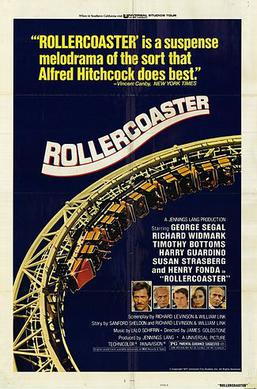Rollercoaster


Rollercoaster
Release Date: June 17, 1977
Runtime: 119 minutes
Rating: PG
Studio: Universal Pictures
Director: James Goldstone
Cast: George Segal; Richard Widmark; Timothy Bottoms; Henry Fonda; Susan Strasberg; Helen Hunt; Charlie Tuna
This 1977 thriller is often erroneously lumped in with the disaster movie cycle of the early- mid 1970s, more than anything a result both of the timing of its production and its release. Yet to group this film alongside Airport (1970), Earthquake (1974), and the like isn’t really fair to this entertaining time-waster. More accurately, Rollercoaster is closer to action films of the period such as The Taking of Pelham 123 (1974), than with the Airport series of films (some of which Rollercoaster producer Jennings Lang himself produced).
The unquestionably thinly-plotted (mad bomber wreaks havoc at amusement parks around the country by planting small bombs on rollercoasters) movie blasts off to a sensational start as nameless everyman Timothy Bottoms affixes what appears to be a homemade bomb to the side of a rollercoaster as an amusement park is opening for the day. (Several amusement parks were used as locations in this movie including Magic Mountain outside of LA, and Kings Dominion in Virginia). The opening credits roll as the parks’ employees dust off the rides, wrap the ubiquitous cotton candy, and remove the overnight protective boards from the carnival games. Director James Goldstone (who would next go on to direct the far inferior and vastly dumber When Time Ran Out… (1980) for disaster doyenne Irwin Allen) effectively chooses to rely upon ambient amusement park sounds to open his film, and to utilize Lalo Schifrin’s Bernard Herrmann-esque score only sparingly. It’s an approach that dramatically underscores the brooding tension, particularly as the rides and the rollercoasters get going and we hear that distinctive whoosh of the coaster cars as they whizz along the tracks. (Along with Earthquake, Midway (1976), and Battlestar Galactica (1978), Rollercoaster was presented in Sensurround, an amplifying sound system used in order to highlight this very feature.*)
Star George Segal isn’t quite an action hero and it’s a good thing too since he’s not really required to be. Segal’s Harry Calder is the rep for the insurance company that built The Rocket, the rollercoaster that explodes in the opening scene. (Interestingly, this opener would have benefitted from more carnage to drive home the horror, but apparently this very carnage was softened by the filmmakers in order to procure a PG rating.* The resulting scene feels as though it was chopped off in the editing room, which it probably was.) For some flimsy reason, the bomber takes a shine to Harry and demands to communicate only with and through him. Harry’s reluctance, however, contributes to the running gag of his courageous attempt to quit smoking when he has never needed a cigarette more! (I wonder if this is where the famous “Looks like I picked the wrong week to quit…” gag in Airplane! (1980) was born out of). Richard Widmark lends gravitas to the role of the lead investigator in this case with whom Harry has the kind of adversarial relationship required by movies of this vein. Susan Strasberg is wasted as Harry’s current wife as is Henry Fonda (!) in what amounts to a glorified cameo. Of note is the casting of a young Helen Hunt in her film debut as Harry’s daughter.
To say that Rollercoaster is a disaster movie in the sense that Earthquake or The Towering Inferno (1974) are disaster movies is a misnomer. Applying some common conventions of the disaster film, Rollercoaster only tangentially fits the mold. For one thing, the all-star cast is significantly smaller than what is typically seen in most films of this type (Segal, Widmark, Strasberg, Fonda). Furthermore, the disaster in Rollercoaster is man-made and not natural as is the case in canonical disaster films (the fire in The Towering Inferno, the tidal wave in The Poseidon Adventure (1972), the earthquake in Earthquake, etc.) Lastly (but not leastly) and crucially, the rollercoaster bombings in Rollercoaster are separate, yet connected incidents that occur at different amusement parks throughout the course of the film. When we consider the familiar disaster film, it is one disaster that kicks off at or near the beginning of the film and its effects escalate in danger until the conclusion (for example, the tidal wave capsizes the cruise ship at the beginning of The Poseidon Adventure and the characters must maneuver through the dangerous water to safety over the course of the next two hours).
So while Rollercoaster, however unfairly, remains clustered with more popular disaster films of the 1970s, it should really be looked upon as a moderately enjoyable diversion that adequately scratches one’s action-thriller itch. No more, no less.
*All asterisks indicate items located on Rollercoaster’s IMDb trivia page
